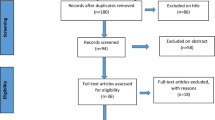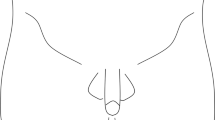Abstract
Purpose
Tension-free mesh repair of inguinal hernia has led to uniformly low recurrence rates. Morbidity associated with this operation is mainly related to chronic pain. No consensus guidelines exist for the management of this condition. The goal of this study is to design an expert-based algorithm for diagnostic and therapeutic management of chronic inguinal postoperative pain (CPIP).
Methods
A group of surgeons considered experts on inguinal hernia surgery was solicited to develop the algorithm. Consensus regarding each step of an algorithm proposed by the authors was sought by means of the Delphi method leading to a revised expert-based algorithm.
Results
With the input of 28 international experts, an algorithm for a stepwise approach for management of CPIP was created. 26 participants accepted the final algorithm as a consensus model. One participant could not agree with the final concept. One expert did not respond during the final phase.
Conclusion
There is a need for guidelines with regard to management of CPIP. This algorithm can serve as a guide with regard to the diagnosis, management, and treatment of these patients and improve clinical outcomes. If an expectative phase of a few months has passed without any amelioration of CPIP, a multidisciplinary approach is indicated and a pain management team should be consulted. Pharmacologic, behavioral, and interventional modalities including nerve blocks are essential. If conservative measures fail and surgery is considered, triple neurectomy, correction for recurrence with or without neurectomy, and meshoma removal if indicated should be performed. Surgeons less experienced with remedial operations for CPIP should not hesitate to refer their patients to dedicated hernia surgeons.




Similar content being viewed by others
References
Franneby U, Sandblom G, Nordin O et al (2006) Risk factors for long-term pain after hernia surgery. Ann Surg 244:212–219
Bay-Nielsen M, Nilsson E, Nordin P, Kehlet H (2004) Swedish Hernia Data Base the Danish Hernia Data B. Chronic pain after open mesh and sutured repair of indirect inguinal hernia in young males. Br J Surg 91(10):1372–1376
Callesen T, Bech K, Kehlet H (1999) Prospective study of chronic pain after groin hernia repair. Br J Surg 86(12):1528–1531
Cunningham J, Temple WJ, Mitchell P, Nixon JA, Preshaw RM, Hagen NA (1996) Cooperative hernia study. Pain in the postrepair patient. Ann Surg 224(5):598–602
Holzheimer RG (2007) Low recurrence rate in hernia repair–results in 300 patients with open mesh repair of primary inguinal hernia. Eur J Med Res 12(1):1–5
Mikkelsen T, Werner MU, Lassen B, Kehlet H (2004) Pain and sensory dysfunction 6 to 12 months after inguinal herniotomy. Anesth Analg 99(1):146–151
Vironen J, Nieminen J, Eklund A, Paavolainen P (2006) Randomized clinical trial of Lichtenstein patch or Prolene Hernia System for inguinal hernia repair. Br J Surg 93(1):33–39
Kehlet H, Jensen TS, Woolf CJ (2006) Persistent postsurgical pain: risk factors and prevention. Lancet 367(9522):1618–1625
Kehlet H (2008) Chronic pain after groin hernia repair. Br J Surg 95(2):135–136
Alfieri S, Amid PK, Campanelli G et al (2011) International guidelines for prevention and management of post-operative chronic pain following inguinal hernia surgery. Hernia 15(3):239–249
Heise CP, Starling JR (1998) Mesh inguinodynia: a new clinical syndrome after inguinal herniorrhaphy? J Am Coll Surg 187(5):514–518
Masukawa K, Wilson SE (2010) Is postoperative chronic pain syndrome higher with mesh repair of inguinal hernia? Am Surg 76(10):1115–1118
Miller JP, Acar F, Kaimaktchiev VB, Gultekin SH, Burchiel KJ (2008) Pathology of ilioinguinal neuropathy produced by mesh entrapment: case report and literature review. Hernia 12(2):213–216
Yavuz A, Kulacoglu H, Olcucuoglu E et al (2011) The faith of ilioinguinal nerve after preserving, cutting, or ligating it: an experimental study of mesh placement on inguinal floor. J Surg Res 171(2):563–570
Amid PK (2004) Lichtenstein tension-free hernioplasty: its inception, evolution, and principles. Hernia 8(1):1–7
Aasvang E, Kehlet H (2005) Surgical management of chronic pain after inguinal hernia repair. Br J Surg 92(7):795–801
Aasvang EK, Kehlet H (2009) The effect of mesh removal and selective neurectomy on persistent postherniotomy pain. Ann Surg 249(2):327–334
Amid PK, Chen DC (2011) Surgical treatment of chronic groin and testicular pain after laparoscopic and open preperitoneal inguinal hernia repair. J Am Coll Surg 213(4):531–536
Amid PK (2004) Radiologic images of meshoma: a new phenomenon causing chronic pain after prosthetic repair of abdominal wall hernias. Arch Surg 139(12):1297–1298
Inaba T, Okinaga K, Fukushima R et al (2012) Chronic pain and discomfort after inguinal hernia repair. Surg Today 42(9):825–829
Nienhuijs S, Staal E, Strobbe L, Rosman C, Groenewoud H, Bleichrodt R (2007) Chronic pain after mesh repair of inguinal hernia: a systematic review. Am J Surg 194(3):394–400
Jones JH (1995) Education and debate: qualitative research: consensus methods for medical and health services research. BMJ 311:376–380
Merskey H, Bogduk N (1994) Classification of chronic pain: descriptions of chronic pain syndromes and definitions of pain terms. Task force of the IASP, 2nd edn. IASP Press, Seattle, pp 209–214
Chen DC, Hiatt JR, Amid PK (2013) Operative management of refractory neuropathic inguinodynia by a laparoscopic retroperitoneal approach. JAMA Surg 148(10):962–967
Amid PK, Chen DC (2011) Surgical treatment of chronic groin and testicular pain after laparoscopic and open inguinal hernia repair. J Am Coll Surg 213(4):531–536
Song JW, Wolf JS Jr, McGillicuddy JE, Bhangoo S, Yang LJ (2011) Laparoscopic triple neurectomy for intractable groin pain: technical report of 3 cases. Neurosurgery 68(2):339–346
Amid PK, Hiatt RH (2007) New understanding of the causes and surgical treatment of postherniorrhaphy inguinodynia and orchalgia. J Am Coll Surg 205(2):381–385
Lichtenstein IL, Shulman AG, Amid PK, Montllor MM (1988) Cause and prevention of postherniorrhaphy neuralgia: a proposed protocol for treatment. Am J Surg 155(6):786–790
Chen DC, Amid PK (2013) Persistent orchialgia after inguinal hernia repair: diagnosis, neuroanatomy, and surgical management: Invited comment to: Role of orchiectomy in severe testicular pain and inguinal hernia surgery: audit of Finnish patient insurance centre Rönka K, Vironen J, Kokki H, Liukkonen T, Paajanen H. Hernia. doi:10.1007/s10029-013-1150-3 [Epub ahead of print]
Conflict of interest
None.
Author information
Authors and Affiliations
Corresponding author
Acknowledgement to the board of international experts who gave consensus
Acknowledgement to the board of international experts who gave consensus
Title | Initials | Name | Hospital | County of origin |
|---|---|---|---|---|
Prof.; MD | R. | Alvarez | Director Proben Hernia Clinic, Guadalajara, Mexico | Mexico |
Prof.; MD, FACS, FRCS | P.K. | Amid | Department of Surgery, Lichtenstein Amid Hernia Clinic at University of California, Los Angeles | USA |
MD, FACS | M.E. | Arregui | Department of Surgery, St. Vincent Hospital, Indianapolis, Indiana | USA |
MD | C.R. | Berney | Department of Surgery, Bankstown-Lidcombe Hospital, University of New South Wales, Bankstown | Australia |
MD | F. | Berrevoet | Department of Surgery, University Hospital Ghent | Belgium |
Prof.; MD, PhD | G. | Campanelli | Department of Surgery, University of Insubria, Varese | Italy |
MD, FACS | D.C. | Chen | Department of Surgery, Lichtenstein Amid Hernia Clinic at University of California, Los Angeles | USA |
Prof.; MD, FACS | R.J. | Fitzgibbons Jr. | Department of Surgery Creighton University School of Medicine, Omaha, Nebraska | USA |
MD, PhD | D. | Van Geldere | Department of Surgery, Isala Klinieken, Zwolle | Netherlands |
MD | C. | De Gheldere | Department of Surgery, Heilige Hart Kliniek, Lier | Belgium |
MD | H. | Van Goor | Department of Surgery, Radboud University Nijmegen Medical Center | Netherlands |
Prof.; MD, PhD | J. | Jeekel | Department of Neuroscience, Erasmus Medical Centre, Rotterdam | Netherlands |
MD | A.N. | Kingsnorth | Department of Surgery, Derriford Hospital, Plymouth | UK |
MD | J.F.M. | Lange Jr. | University Medical Center Groningen | Netherlands |
Prof.; MD, PhD | J.F. | Lange Sr. | Department of Surgery, Erasmus Medical Centre, Rotterdam | Netherlands |
Prof.; MD, PhD | M. | Miserez | Department of Abdominal Surgery, Universitair Ziekenhuis, Leuven | Belgium |
MD, PhD | O. | Mjaland | Department of Surgery, SSHF Kristiansand | Norway |
MD, PhD | A. | Montgomery | Department of Surgery, University Hospital, Malmö | Sweden |
MD | S. | Morales-Conde | Unit of Innovation in Minimally Invasive Surgery, University Hospital Virgen del Roco, Seville | Spain |
MD | F.E. | Muysoms | Department of General Surgery, AZ Maria Middelares, Ghent | Belgium |
MD | E.P. | Pelissier | Department of Digestive Pathology, Institut Montsouris, Paris | France |
MD | W.M. | Reinpold | Department of Surgery, Krankenhaus Reinbek St. Adolf-Stift, Reinbek | Germany |
MD | M.P. | Simons | Department of Surgery, Onze Lieve Vrouwe Gasthuis, Amsterdam | Netherlands |
MD | R.K.J. | Simmermacher | Department of Surgery, University Hospital, Utrecht | Netherlands |
MD | F. | Ugahary | Retired | Netherlands |
MD, PhD | A.R. | Wijsmuller | Department of Surgery, Erasmus Medical Centre, Rotterdam | Netherlands |
Rights and permissions
About this article
Cite this article
Lange, J.F.M., Kaufmann, R., Wijsmuller, A.R. et al. An international consensus algorithm for management of chronic postoperative inguinal pain. Hernia 19, 33–43 (2015). https://doi.org/10.1007/s10029-014-1292-y
Received:
Accepted:
Published:
Issue Date:
DOI: https://doi.org/10.1007/s10029-014-1292-y




